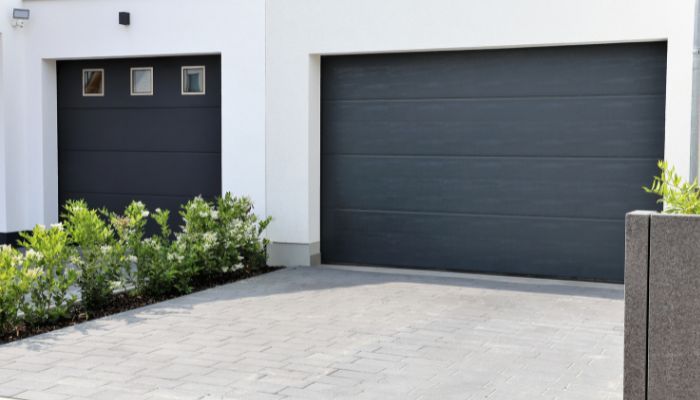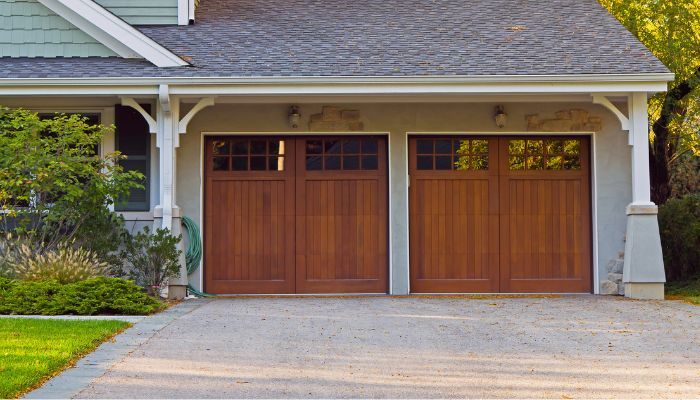
Step-by-Step: The Journey of a Garage Door from Warehouse to Home
When it comes to purchasing a new garage door, customers want to be assured of its quality and longevity. With the right steps followed from factory to warehouse, and from shipping to installation, customers can enjoy a reliable new garage door that will last for years. This overview will discuss the entire process, from crafting and storing the garage door in a factory, through safe and secure shipping, before finally achieving installation. With the right know-how and the right experts available to help, you can have a long-lasting and reliable garage door in no time.
The Manufacturing Process: Crafting a Reliable Garage Door
The manufacturing process of crafting a reliable garage door is an intricate one. It begins with designing the desired form of the door, considering the materials and components needed for production. Once the design is in place, the door elements need to be cut from the materials. This is accomplished with reliable tools, such as die cutters and hand tools. Moreover, machines and other automated systems (like robotic arms) can be used for precise and uniform cutting.
After the components of the garage door have been cut, they need to be fitted together in order for it to function properly. This fitting process requires high levels of craftsmanship, as slight imperfections can cause issues when the door is in use. Furthermore, specialized tools may be needed to help accurately join the components, such as riveting and welding machines, in order to ensure the finished product is as strong and reliable as possible.
Once the garage door is assembled, it is then tested to ensure that it is stable and functions correctly. For instance, different tests may include assessing the door’s resistance to wind or water, its noise level and its overall tightness. Similarly, the door’s performance can be further improved by using insulating materials between components, or adding additional reinforcements.
Finally, the garage door needs a thorough and in-depth inspection to inspect for any visible imperfections or defects, such as cracks, rust, or any warping. If needed, a second inspection may be done afterwards. As a result, the door can be evaluated for internal damage or weaknesses not visible to the naked eye, and if found, it can be repaired or replaced. Consequently, the end product is a reliable and durable garage door that is sure to stand the test of time.
From Factory to Warehouse: Ensuring Quality Storage For Your Garage door
Ensuring quality storage for your garage door is an important step in converting a factory to a warehouse. Proper storage can prevent excess wear and tear on garage door parts, provide secure storage for doors and accessories, and maintain a safe and organized environment. However, it requires careful thought and consideration when choosing the right methods and materials for safe door storage.
Firstly, select the right materials such as pallets, racks, and shelving, to ensure the load is supported properly. Heavy-duty pallets, or shelving, can protect the door against any possible damage. Additionally, stacks of doors can be placed on a floor-mounted rack system, so that each door can be easily removed for gauging or to stock up on inventory. Moreover, when constructing shelves or racks, make sure to leave enough space between the shelves and racks, to prevent accidental damage to the door or its parts.
Once you have the right materials stored properly, you need to consider the placement of garage doors in the warehouse. If possible, it is recommended to keep doors away from locations where they are subject to vibration or dust. Similarly, install a guard rail along the edge of shelves to ensure that the inventory won’t fall off during transportation.
Lastly, garage door manufacturers should check in regularly with the warehouse staff to ensure the proper functioning of storage facilities. Inspections should include verifying the accuracy and quality of their products, and that the storage structure is up-to-date with the latest safety codes. Furthermore, ensure that all components of the garage door, including electrical parts or machinery, are maintained regularly in optimal condition.
In conclusion, when converting a factory to a warehouse for garage door storage, safety, organization, and quality should be the top priorities. With the right materials, placement, and maintenance, you can ensure that your warehouse is providing the best possible storage for your garage door.
The Shipping and Delivery Garage Door Logistics: Ensuring Safe Transit
The safe and efficient delivery of goods is paramount to the success of any logistics operation, and the shipping and delivery garage door is an integral part of the process. It provides a secure passage for goods and ensures that they will be delivered safely to their final destination. However, ensuring safe transit requires careful planning and preparation.
First, a shipping and delivery garage door must be properly maintained and inspected regularly to ensure its integrity. This includes inspecting the frame, hardware, and latch mechanisms for signs of wear and tear, as well as ensuring that the door is regularly serviced. In addition, the door must be kept securely locked to prevent unauthorized access.
The loading and unloading of goods must be done properly to prevent damage. Any hazardous materials must be properly labeled and stored properly, and all transport containers must be inspected for any potential concerns before being loaded onto the truck. Furthermore, the truck itself should be regularly checked for any issues that could threaten the security of the cargo, such as mechanical faults and inadequate safety equipment.
In addition, it is important to have an efficient delivery system in place. This includes efficient routing, tracking, and communication between the delivery team and dispatch. Moreover, it is important to ensure that the truck drivers are properly trained, and that they are familiar with the local area. Similarly, it is vital that the delivery team has access to up-to-date information on the status of the shipment, so as to ensure that any potential delays or unforeseen issues can be quickly addressed.
For instance, if a shipment is due to arrive at its destination late, then the delivery team must be able to modify the route or make other necessary arrangements to ensure timely arrival. In contrast, if a shipment must be delivered urgently, then the delivery team must be able to modify the route or devise an appropriate alternative strategy in order to get the goods to the customer as quickly as possible. As a result, the delivery team must be equipped with the necessary tools to ensure that the job is done quickly and efficiently.
Finally, secure methods of payment must be in place to ensure that customers are able to make payments without any issues. This includes the use of secure payment processing systems and the use of encrypted payments. Furthermore, the delivery personnel must also be trained in secure methods of handling customer data and payments.
Therefore, shipping and delivery garage door logistics involves a number of steps which must be taken in order to ensure safe and efficient transit of goods. Through proper maintenance, training, and secure payment systems, it is possible to ensure that goods will arrive safely and timely at their intended destination.
Garage Door Installation Day: Preparing Your Home for a New Door
Garage Door Installation Day is an exciting time for homeowners. Preparing the home ahead of time can save homeowners time and ensure the installation goes as smoothly as possible. One way to prepare is by clearing out any items that may be underneath or around the door. Being conscious of the area leading up to the door will minimize potential accidents. Moreover, having a clear pathway will allow the installers to move quickly and efficiently throughout the day. Furthermore, it is important to secure any pets that may interfere with the installers.
It is also beneficial to have a helper present at the installation. This can help in the organization of the job as well as increase the safety for the technician. Having another person around to provide an extra set of ears is also helpful in picking up details that the installers may recommend. On the other hand, One should make sure the helper is aware of any safety protocols and is comfortable with the task at hand.
In addition, it is important to check the door itself for any damages. Doing this before the installation day will give the homeowner time to replace any broken parts and prevent potential future accidents. Similarly, it is also important to inspect the door tracks for dirt, debris, as well as any kinks. Taking the time to prepare the tracks can save the contractor time and effort. Therefore, homeowners should not be afraid to step in and help in the process.
Finally, having the appropriate tools for installation is an invaluable asset. Homeowners should consider supplying some of their own tools to speed up the process, and some of these tools may include a ladder, drill and assorted screwdrivers. As a result, it is also beneficial to check the manufacturer’s guidelines on the tools required for the installation. By being mindful and taking the time to properly prepare the home, the garage door installation can proceed without any issues.
Final Thoughts
The manufacturing process entails crafting the door out of high-quality materials, the warehouse storage requires a climate-controlled setting and needs to be closely monitored, the shipping and delivery logistics depend on the size and weight of the garage door for selecting the best mode of transport and delivery rate, and the installation day would include prepping the home for a new garage door to minimize any issues that may arise. Ultimately, these steps of the process guarantee that the garage door is of the highest quality and will be safely and securely shipped to the customer’s home and quickly and properly installed. This well-defined and comprehensive process is essential for ensuring that all customers receive the best quality garage doors for their homes.
Frequently Asked Questions
How long does it typically take for a garage door to go from manufacturing to installation?
The length of time it takes to have a garage door manufactured and installed typically depends on the type of door, the complexity of the job, and other factors. Complex doors or those with custom finishes or dimensions may take longer to fabricate. Generally, installation times range from 1 – 2 days, depending on the material, style, and size of the door.
How are garage doors stored safely in the warehouse?
Garage doors must be carefully protected when they are stored in a warehouse. The garage doors should be stored on their edges or flat on a pallet in a dry and secure area. Do not place anything on top of the garage doors. Straps can be used to secure the pallet and keep the doors from shifting or falling. Additionally, use caution when moving and lifting the garage doors to prevent damage.
What can I expect on the day of installation?
On the day of your installation, you can expect the technician to arrive at the designated time. They will arrive in a vehicle with all the required tools and equipment. They will take the necessary measurements and ask you any questions before starting the installation process. Once they have all the necessary information they will begin the installation process. This includes mounting hardware, positioning equipment, running cables, testing connections, and configuring settings. Once everything is up and running, they will complete a final test and provide any relevant instructions on how to properly use and maintain the installed equipment.
Are there any preparations I need to make before the installation day?
Yes, there are some preparations you should make before your installation day. You should make sure that you know where you want to install your product. Additionally, you should make sure you have any necessary tools or materials to assist in the installation. Make sure your space is clear and all obstacles are removed. Finally, read through the instructions before your installation day to make sure you understand how the installation should be performed.
Table of Contents
More Blogs to Check Out!
Categories











Leave a Reply